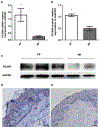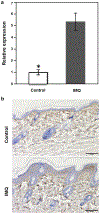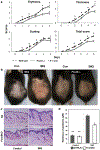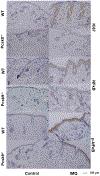Potentiation of Psoriasis-Like Inflammation by PCSK9
- PMID: 30395847
- PMCID: PMC7546417
- DOI: 10.1016/j.jid.2018.07.046
Potentiation of Psoriasis-Like Inflammation by PCSK9
Abstract
Psoriasis is a systemic inflammatory disease, associated with metabolic disorders, including high level of low-density lipoprotein. PCSK9, which promotes the degradation of low-density lipoprotein receptors and, therefore, the increased concentration of circulating low-density lipoprotein, is also involved in inflammation. This study aims to examine the role of PCSK9 in psoriasis and to investigate the potential of topically applying small interfering RNA targeting Pcsk9 as a psoriasis treatment. We investigated the expression of PCSK9 in lesions of psoriasis patients and imiquimod-induced psoriatic reactions in Pcsk9-knockout and Pcsk9 small interfering RNA-treated mice, and we also used cultured human keratinocytes to investigate the role of PCSK9 in regulating cell proliferation and apoptosis. We found that PCSK9 is overexpressed in psoriatic lesions and that suppressing Pcsk9 can decrease the inflammatory reaction induced by imiquimod treatment and inhibit hyperproliferation of keratinocytes. We also found that suppressing PCSK9 can significantly alter the cell cycle and induce apoptosis of human keratinocytes. Taken together, our findings indicate that PCSK9 plays an important role in psoriasis and may be a therapeutic target.
Copyright © 2018 The Authors. Published by Elsevier Inc. All rights reserved.
Conflict of interest statement
CONFLICT OF INTEREST
The authors state no conflict of interest.
Figures






Similar articles
-
Cornulin Is Induced in Psoriasis Lesions and Promotes Keratinocyte Proliferation via Phosphoinositide 3-Kinase/Akt Pathways.J Invest Dermatol. 2019 Jan;139(1):71-80. doi: 10.1016/j.jid.2018.06.184. Epub 2018 Sep 25. J Invest Dermatol. 2019. PMID: 30009832
-
PI3Kδ Sustains Keratinocyte Hyperproliferation and Epithelial Inflammation: Implications for a Topically Druggable Target in Psoriasis.Cells. 2021 Oct 2;10(10):2636. doi: 10.3390/cells10102636. Cells. 2021. PMID: 34685616 Free PMC article.
-
A Critical Role of the IL-1β-IL-1R Signaling Pathway in Skin Inflammation and Psoriasis Pathogenesis.J Invest Dermatol. 2019 Jan;139(1):146-156. doi: 10.1016/j.jid.2018.07.025. Epub 2018 Aug 16. J Invest Dermatol. 2019. PMID: 30120937 Free PMC article.
-
PCSK9: A novel inflammation modulator in atherosclerosis?J Cell Physiol. 2019 Mar;234(3):2345-2355. doi: 10.1002/jcp.27254. Epub 2018 Sep 24. J Cell Physiol. 2019. PMID: 30246446 Review.
-
The immune functions of PCSK9: Local and systemic perspectives.J Cell Physiol. 2019 Nov;234(11):19180-19188. doi: 10.1002/jcp.28612. Epub 2019 Apr 4. J Cell Physiol. 2019. PMID: 30950043 Review.
Cited by
-
Anti-Inflammatory Effects of Lipid-Lowering Drugs and Supplements-A Narrative Review.Nutrients. 2023 Mar 21;15(6):1517. doi: 10.3390/nu15061517. Nutrients. 2023. PMID: 36986246 Free PMC article. Review.
-
Coming Back to Physiology: Extra Hepatic Functions of Proprotein Convertase Subtilisin/Kexin Type 9.Front Physiol. 2020 Dec 7;11:598649. doi: 10.3389/fphys.2020.598649. eCollection 2020. Front Physiol. 2020. PMID: 33364976 Free PMC article. Review.
-
Unveiling Novel Protein Biomarkers for Psoriasis Through Integrated Analysis of Human Plasma Proteomics and Mendelian Randomization.Psoriasis (Auckl). 2024 Dec 7;14:179-193. doi: 10.2147/PTT.S492205. eCollection 2024. Psoriasis (Auckl). 2024. PMID: 39669686 Free PMC article.
-
Methotrexate Decreases the Level of PCSK9-A Novel Indicator of the Risk of Proatherogenic Lipid Profile in Psoriasis. The Preliminary Data.J Clin Med. 2020 Mar 26;9(4):910. doi: 10.3390/jcm9040910. J Clin Med. 2020. PMID: 32225075 Free PMC article.
-
Role of Proprotein Convertase Subtilisin/Kexin Type 9 in the Pathogenesis of Graves' Orbitopathy in Orbital Fibroblasts.Front Endocrinol (Lausanne). 2021 Jan 8;11:607144. doi: 10.3389/fendo.2020.607144. eCollection 2020. Front Endocrinol (Lausanne). 2021. PMID: 33488522 Free PMC article.
References
-
- Davidovici BB, Sattar N, Prinz J, Puig L, Emery P, Barker JN, et al. Psoriasis and systemic inflammatory diseases: potential mechanistic links between skin disease and co-morbid conditions. J Invest Dermatol 2010;130: 1785–96. - PubMed
-
- Della Badia LA, Elshourbagy NA, Mousa SA. Targeting PCSK9 as a promising new mechanism for lowering low-density lipoprotein cholesterol. Pharmacol Ther 2016;164:183–94. - PubMed
-
- Dreiher J, Weitzman D, Davidovici B, Shapiro J, Cohen AD. Psoriasis and dyslipidaemia: a population-based study. Acta Derm Venereol 2008;88: 561–5. - PubMed
-
- Ferri N, Ruscica M. Proprotein convertase subtilisin/kexin type 9 (PCSK9) and metabolic syndrome: insights on insulin resistance, inflammation, and atherogenic dyslipidemia. Endocrine 2016;54:588–601. - PubMed
Publication types
MeSH terms
Substances
Grants and funding
LinkOut - more resources
Full Text Sources
Medical
Molecular Biology Databases
Miscellaneous

